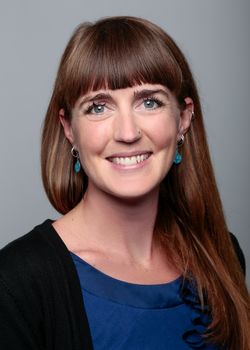Dr. Miranda Böttcher
Areas of Expertise
- Climate policy
- Foresight
- Sustainability governance
Ocean/climate governance nexus, Marine infrastructures, Marine-based Carbon Dioxide Removal, Foresight, Knowledge Politics
ProjectsShort Curriculum vitae
Since 2025: IPCC AR7, Lead author Working Group III Report (Mitigation of Climate Change)
Since 2023: Adjunct Assistant Professor, Copernicus Institute of Sustainable Development, Utrecht University
Since 2024: Project Leader in the »ASMASYS II« research project
Since 2021: Associate at SWP, Research Division EU/Europe (2021–2024). Research Cluster Climate Policy and Politics (since 2023); Research Division Global Issues (since 2024)
2015 - 2021: Research Associate, Institute Research Institute for Sustainability (RIFS)
2014 - 2015: Research Analyst & Workshop Facilitator, Foresight Intelligence, Berlin, Germany
Memberships
US National Academies of Sciences, Engineering, Medicine (NASEM): Marine Carbon Dioxide Removal Standing Committee
Review Editor: 7th UNEP Global Environment Outlook Report (GEO-7)
United Nations Joint Group of Experts on the Scientific Aspects of Marine Environmental Protection (GESAMP) Working Group 41: Ocean Interventions for Climate Mitigation
European Marine Board (EMB): Working Group on Marine Carbon Dioxide Removal (mCDR)
Horizon Europe Project Advisory Board: Strategies for the evaluation and assessment of ocean-based Carbon dioxide removal (SEAO2-CDR)
Editorial Board: Communications Earth and Environment (Nature)
Visiting Fellowships
Institute for Resources, Environment and Sustainability (IRES), University of British Columbia (2022); Australian-German Climate and Energy College, University of Melbourne (2019); Institute for Science, Innovation and Society, University of Oxford (2018)
SWP Publications
-
Foresight: Multilevel Climate Policy in 2030
Research Division EU/Europe, Working Paper Nr. 02/2024, August 2024, 35 Pages -
Foresight*: Pathogens from the Permafrost
Combating the Spread of an Animal-borne Disease with or without Russia
SWP Comment 2024/C 23, 21.06.2024, 7 Pagesdoi:10.18449/2024C23
-
The High Seas Treaty: A new hub for global ocean governance
The United Nations has adopted a treaty to protect the high seas. To leverage the potential of the new “High Seas Treaty” as a global hub for ocean governance, the EU and Germany should start planning now how to engage strategically within this forum, argue Miranda Boettcher and Gerrit Hansen.
Point of View, 21.06.2023 -
“Carbon Management”: Opportunities and risks for ambitious climate policy
SWP Comment 2023/C 29, 26.05.2023, 8 Pagesdoi:10.18449/2023C29
-
mCDR Foresight Scenarios: Policy Frameworks for Marine Carbon-Dioxide Removal in 2040
Working Paper Research Division EU/Europe 2023/Nr. 02, April 2023, 35 Pages -
Into the Blue: The Role of the Ocean in Climate Policy
Europe needs to clarify the balance between protection and use
SWP Comment 2023/C 12, 01.03.2023, 7 Pagesdoi:10.18449/2023C12
External publications
-
Accounting and monitoring challenges for blue carbon enhancement in national climate policy targets and international carbon markets
in: Carbon Management, 16(1), 01.12.2025.doi:10.1080/17583004.2025.2585895
-
Monitoring, Reporting and Verification for Marine Carbon Dioxide Removal
in: Muñiz Piniella, A., Rodriguez Perez, A., Kellett, P., Alexander, B., Bayo Ruiz, F., Heymans, J. J. (Eds.), Future Science Brief N°. 13 of the European Marine Board, 2025.doi:10.5281/zenodo.17435116
-
A prudent planetary limit for geologic carbon storage
in: Nature, 645, pp. 124–132, 03.09.2025.doi:10.1038/s41586-025-09423-y
-
A Scientific Summary for Policy-Makers: the State of the Science for Marine Carbon Dioxide Removal (mCDR)
in: Joint Group of Experts on the Scientific Aspects of Marine Environmental Protection (GESAMP), UNESCO-IOC, IOC Technical Series, 209, 2025. -
Exploring Site-Specific Carbon Dioxide Removal Options With Storage or Sequestration in the Marine Environment – The 10 Mt CO₂ yr⁻¹ Removal Challenge for Germany
in: Earth's Future, 13, 4, April 2025doi:10.1029/2024EF004902
-
A holistic assessment framework for marine carbon dioxide removal options
in: Environmental Research Letters, 21, 04.04.2025doi:10.1088/1748-9326/adc93f

